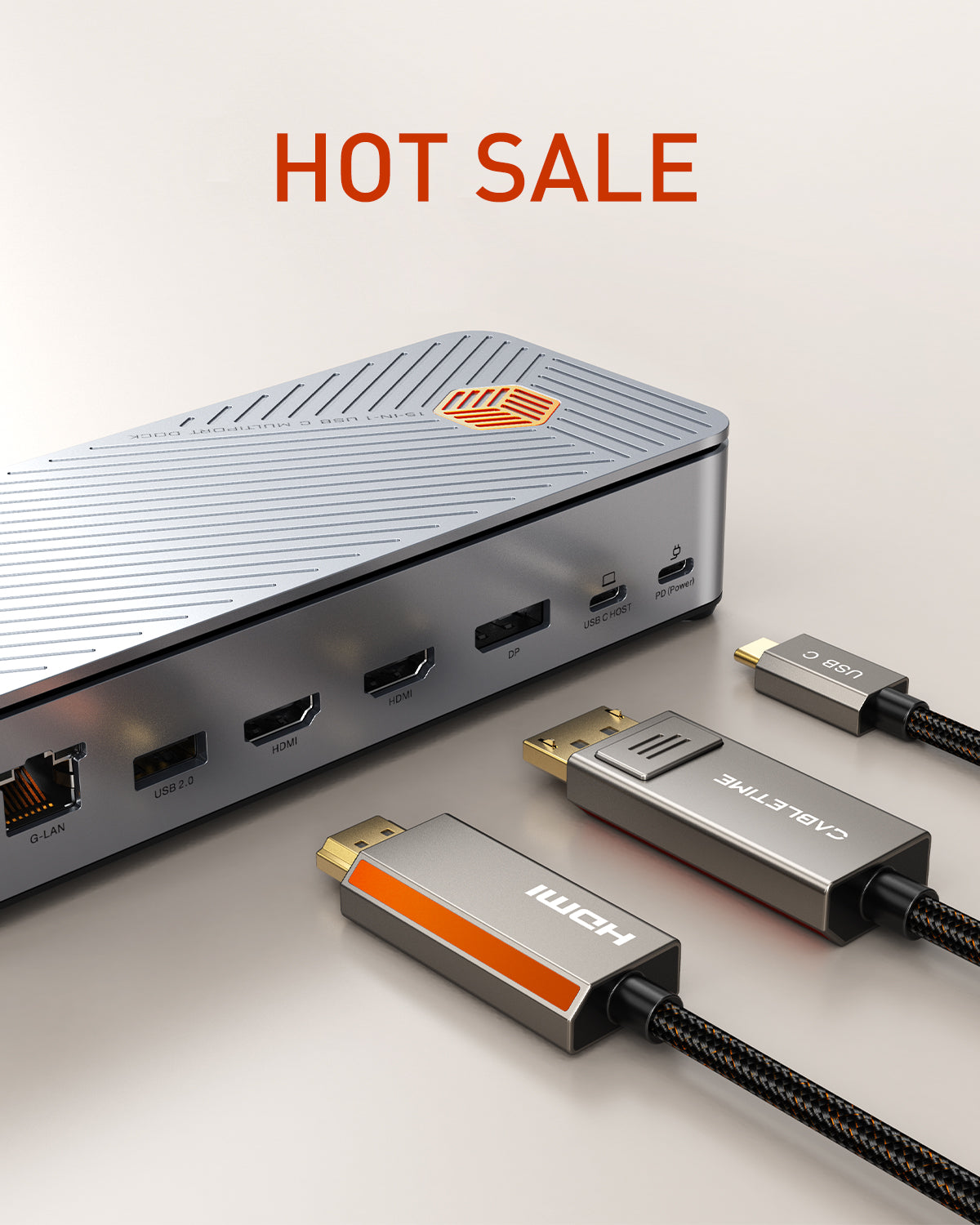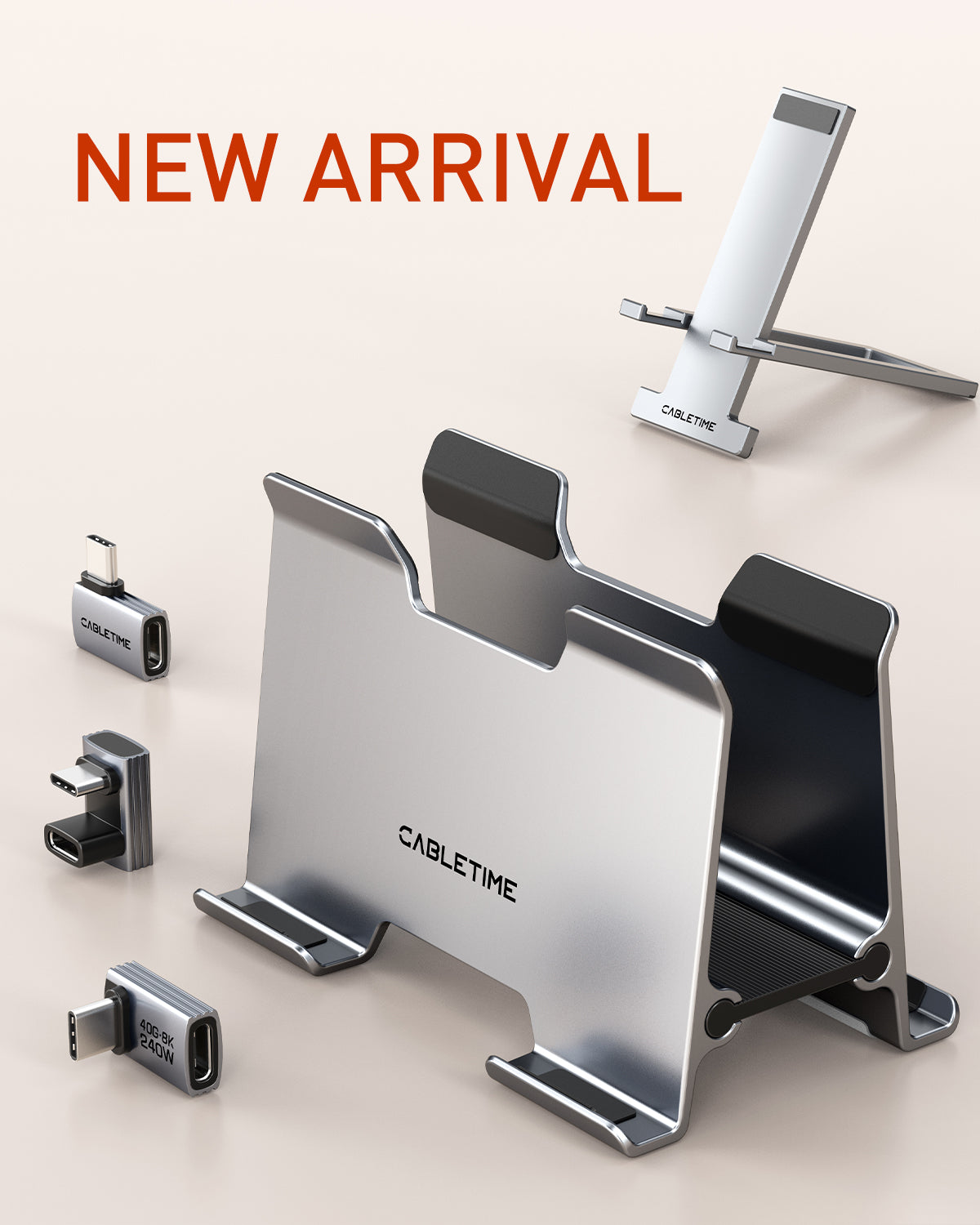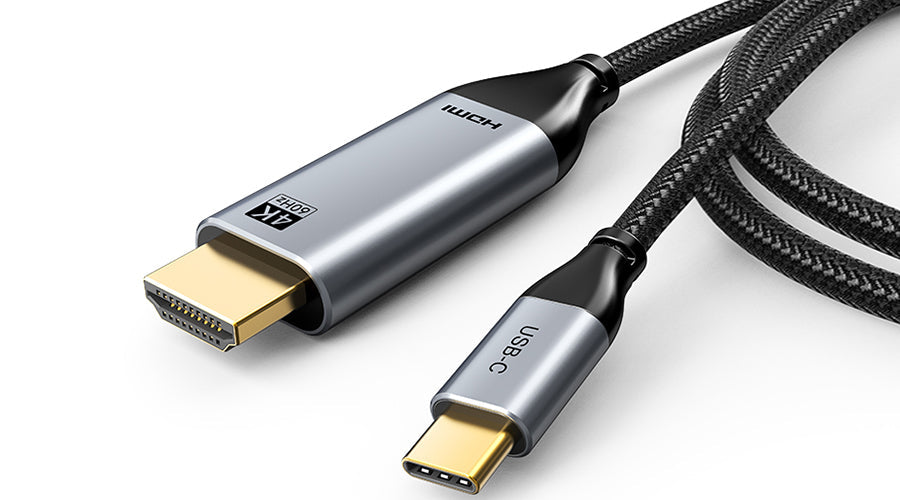Quando vuoi collegare i tuoi dispositivi moderni, come laptop, smartphone, tablet, TV e monitor, a display esterni, hai due opzioni principali: USB-C e HDMI. Questi sono i due connettori più ampiamente utilizzati per la trasmissione di dati, audio e video, nonché per la ricarica dei dispositivi. Tuttavia, non sono la stessa cosa e hanno caratteristiche, vantaggi e limitazioni diverse di cui dovresti essere a conoscenza prima di sceglierne uno. In questo articolo, confronteremo USB-C e HDMI in termini di specifiche, prestazioni e applicazione in diversi scenari. Suggeriremo anche alcuni dei migliori cavi USB-C e HDMI per i tuoi dispositivi e daremo un'occhiata al futuro di questi connettori. Entro la fine di questo articolo, avrai una migliore comprensione di USB-C e HDMI e di come scegliere il migliore per le tue esigenze.
Indice dei contenuti
- 1. Introduzione
- 2. Panoramica di USB-C e HDMI
- 3. Confronto tra prestazioni e applicazioni
- 4. Scelta di USB-C e HDMI al momento del cavo
- 5. Tendenze future e conclusione
- 6. Le persone chiedono anche
- 6.1 L'USB-C può sostituire l'HDMI in tutti gli scenari oppure ci sono delle limitazioni alle sue capacità video?
- 6.2 Quali sono le implicazioni del passaggio a USB-C per i dispositivi legacy che supportano solo HDMI?
- 6.3 In che modo le capacità di erogazione di energia dell'USB-C si confrontano con quelle dell'HDMI quando si tratta di caricare i dispositivi?
- 6.4 Esistono tecnologie emergenti che potrebbero sfidare il predominio di USB-C e HDMI in futuro?
- 6.5 Quali sono le best practice per gestire i cavi e mantenere la qualità del segnale sia con USB-C che con HDMI?
Introduzione

Panoramica di USB-C e HDMI
USB-C
USB-C, noto anche come USB Type-C, è un tipo di connettore USB (Universal Serial Bus) introdotto nel 2014. È un connettore piccolo, reversibile e versatile che può fornire sia alta potenza che alte velocità di trasferimento dati. Può supportare vari standard USB, come USB 2.0, USB 3.0, USB 3.1 e USB 3.2, così come altri protocolli, come DisplayPort, Thunderbolt e HDMI, tramite la funzione Alternate Mode. Ciò significa che USB-C come Cavo USB C Thunderbolt 3 certificato Intel può essere utilizzato per il trasferimento dati, la ricarica, l'uscita video e l'uscita audio, a seconda del dispositivo e del cavo.Grazie alla sua praticità e funzionalità, l'USB-C sta diventando lo standard per molti dispositivi, come smartphone, laptop e tablet.
Cavo HDMI
HDMI (High Definition Multimedia Interface) è un'interfaccia audio/video proprietaria per la trasmissione di dati video non compressi e dati audio digitali compressi/non compressi da un dispositivo sorgente conforme a HDMI, come un laptop, a un dispositivo di visualizzazione compatibile, come una TV o un monitor. È stata introdotta nel 2002 e da allora si è evoluta attraverso diverse versioni, come HDMI 1.4, HDMI 2.0 e HDMI 2.1, ciascuna delle quali offre maggiore larghezza di banda, risoluzione e frame rate. HDMI come Cavo HDMI 2.1 ottico attivo AOC 8K 60Hz 48Gbps HDR è utilizzato principalmente per collegare dispositivi multimediali, come TV, console di gioco e sistemi home theater, e per fornire audio e video di alta qualità e ad alta definizione. HDMI è ampiamente compatibile con vari dispositivi e supporta vari formati, come 4K, HDR, Dolby Vision e Dolby Atmos.
Sia USB-C che HDMI sono diffusi e compatibili con vari dispositivi, ma hanno scopi e funzioni diverse. USB-C è più versatile e flessibile, mentre HDMI è più dedicato e stabile.

| Caratteristica | USB-C | Cavo HDMI |
| Forma del connettore | Piccolo, reversibile, rettangolare | Grande, non reversibile, trapezoidale |
| Perni del connettore | 24 | 19 |
| Protocolli supportati | USB 2.0, USB 3.0, USB 3.1, USB 3.2, DisplayPort, Thunderbolt, HDMI (tramite modalità alternativa) | Cavo HDMI |
| Dispositivi supportati | Smartphone, laptop, tablet, monitor, TV, console per videogiochi, ecc. | Computer portatili, monitor, TV, console per videogiochi, sistemi home theater, ecc. |
| Risoluzioni e frequenze di aggiornamento supportate | Fino a 4K a 60 Hz (tramite modalità alternativa DisplayPort) | Fino a 8K a 60Hz o 4K a 120Hz (HDMI 2.1) |
| Formati supportati | Dipende dal protocollo utilizzato (ad esempio DisplayPort supporta HDR10, Dolby Vision, ecc.) | 4K, HDR, Dolby Vision, Dolby Atmos, ecc. |
| Larghezza di banda | Fino a 20 Gbps (USB 3.2) o 40 Gbps (Thunderbolt 3) | Fino a 48 Gbps (HDMI 2.1) |
| Erogazione di potenza | Fino a 100W | Fino a 5 V/0,05 A (HDMI 1.4) o 5 V/0,09 A (HDMI 2.0) |
| Trasferimento dati | SÌ | NO |
| Ricarica | SÌ | NO |
| Uscita video | SÌ | SÌ |
| Uscita audio | SÌ | SÌ |
Confronto tra prestazioni e applicazioni
Velocità di trasferimento dati di USB-C e HDMI
Le velocità di trasferimento dati di USB-C e HDMI dipendono rispettivamente dallo standard USB e dalla versione HDMI che supportano. Ad esempio, Cavo di ricarica USB 3.0 A a USB C Superspeed 5 Gbps da 3 m supporta velocità fino a 5 Gbps, mentre Cavo HDMI 2.1 8K 48 Gbps intrecciato può supportare una larghezza di banda fino a 48 Gbps. Tuttavia, queste velocità non sono direttamente confrontabili, poiché USB-C si concentra sul trasferimento dati, mentre HDMI si concentra sulla trasmissione audio e video. Pertanto, le prestazioni di USB-C e HDMI in termini di qualità video e trasmissione audio dipendono da altri fattori, come la risoluzione, la frequenza dei fotogrammi, la profondità del colore e il formato audio del contenuto.
Qualità video di USB-C e HDMI
In generale, USB-C può supportare l'uscita video fino a 4K a 60 Hz e l'uscita audio fino a 7.1 canali, a seconda del dispositivo e del cavo. Tuttavia, USB-C si basa sulla funzionalità Alternate Mode per trasmettere segnali video e audio, il che significa che utilizza un altro protocollo, come DisplayPort o HDMI, sotto il cofano. Ciò potrebbe causare alcuni problemi di compatibilità o degradazione della qualità, a seconda del dispositivo e del cavo. Inoltre, USB-C potrebbe non supportare alcune funzionalità avanzate, come HDR, Dolby Vision o Dolby Atmos, che HDMI può supportare.

Trasmissione audio tramite USB-C e HDMI
HDMI, d'altra parte, può supportare l'uscita video fino a 8K a 60 Hz come Cavo HDMI 2.1 ottico attivo AOC 8K 60Hz 48Gbps HDRe uscita audio fino a 32 canali, a seconda della versione HDMI, del dispositivo e del cavo.HDMI è progettato per la trasmissione audio e video e supporta vari formati e funzionalità, come 4K, HDR, Dolby Vision, Dolby Atmos e altro. HDMI offre una qualità video e audio più stabile e coerente, poiché non si basa su un altro protocollo o modalità per trasmettere segnali. Tuttavia, HDMI potrebbe non supportare alcuni dispositivi o standard più recenti, come Thunderbolt o USB-C, che USB-C può supportare.
Pertanto, le prestazioni e l'applicazione di USB-C e HDMI in termini di velocità di trasferimento dati, qualità video e trasmissione audio variano a seconda dello scenario. Ad esempio, se si desidera collegare il laptop a un monitor 4K e trasferire dati contemporaneamente, Cavo Thunderbolt 4 certificato Intel da USB C a USB C 8k 60HZ potrebbe essere una scelta migliore, in quanto offre velocità di trasferimento dati più elevate e una qualità video decente. Tuttavia, se vuoi collegare la tua console di gioco a una TV 4K e goderti un audio e un video immersivi, HDMI potrebbe essere una scelta migliore, in quanto offre una qualità video più elevata e più funzionalità audio.
Compatibilità e flessibilità
La compatibilità e la flessibilità di USB-C e HDMI dipendono dai dispositivi e dai cavi utilizzati. USB-C è più compatibile e flessibile, in quanto può supportare vari standard USB e altri protocolli, come DisplayPort, Thunderbolt e HDMI, tramite la funzionalità Alternate Mode.
HDMI è meno compatibile e flessibile, poiché supporta solo un protocollo, ovvero HDMI. Ciò significa che HDMI può essere utilizzato solo per la trasmissione audio e video, con dispositivi dotati di porte HDMI, come TV, console di gioco e sistemi home theater. Tuttavia, HDMI è più standardizzato e coerente, poiché ha specifiche e versioni chiare, ampiamente adottate da vari dispositivi e produttori.
Pertanto, la compatibilità e la flessibilità di USB-C e HDMI dipendono dai dispositivi e dai cavi utilizzati. Ad esempio, se hai un dispositivo dotato sia di porte USB-C che HDMI, come un laptop, puoi scegliere USB-C o HDMI per connetterti a un display esterno, a seconda delle funzionalità e delle modalità di cui hai bisogno. Tuttavia, se hai un dispositivo dotato solo di porte USB-C, come uno smartphone, potresti aver bisogno di un adattatore o di un convertitore per connetterti a un display HDMI, o viceversa.
Scelta di USB-C e HDMI al momento del cavo
Se stai cercando i migliori cavi USB-C e HDMI per i tuoi dispositivi, puoi trovarli su Cable Time, il principale negozio online di cavi e accessori. Ecco alcuni dei nostri consigli per cavi USB-C e HDMI:
S
Consigli per i cavi USB-C
Se hai bisogno di un cavo USB-C che supporti il trasferimento dati, la ricarica e l'uscita video, puoi scegliere Cavo USB-C a USB-C di Cable Time, che supporta USB 3.1 Gen 2, USB-PD e DisplayPort Alternate Mode. Può fornire velocità fino a 10 Gbps, potenza fino a 100 W e uscita video fino a 4K a 60 Hz. È compatibile con vari dispositivi, come smartphone, laptop e tablet, dotati di porte USB-C. È anche resistente e flessibile, con un design in nylon intrecciato e una lunghezza di 6,6 piedi.
Se hai bisogno di un cavo USB-C che supporti l'uscita video e l'uscita audio, puoi scegliere il cavo USB-C a HDMI di Cable Time, che supporta la modalità alternativa HDMI. Può fornire un'uscita video fino a 4K a 60 Hz e un'uscita audio fino a 7.1 canali. È compatibile con vari dispositivi, come smartphone, laptop e tablet, dotati di porte USB-C e dispositivi, come TV, monitor e proiettori, dotati di porte HDMI. È anche robusto e affidabile, con un connettore placcato in oro e una lunghezza di 6 piedi.
Raccomandazioni per i cavi HDMI
Se hai bisogno di un cavo HDMI che supporti video e audio di alta qualità, puoi scegliere Cable Time High Cavo HDMI 8K ad alta velocità 48 Gbps per proiettore PS3 Xbox, che supporta HDMI 2.1. Può fornire un'uscita video fino a 8K a 60 Hz e un'uscita audio fino a 32 canali. Supporta anche varie funzionalità, come HDR, Dolby Vision, Dolby Atmos e altro. È compatibile con vari dispositivi, come TV, console di gioco e sistemi home theater, dotati di porte HDMI. È anche resistente e flessibile, con un design in nylon intrecciato e una lunghezza di 10 piedi.
Se hai bisogno di un cavo HDMI che supporti la trasmissione video e audio su lunghe distanze, puoi scegliere Cavo HDMI 2.0 in fibra ottica attiva(DOC) , che supporta HDMI 2.0. Può fornire un'uscita video fino a 4K a 60 Hz e un'uscita audio fino a 7.1 canali. Supporta anche varie funzionalità, come HDR, Dolby Vision, Dolby Atmos e altro ancora. È compatibile con vari dispositivi, come TV, console di gioco e sistemi home theater, dotati di porte HDMI.
Tendenze future e conclusione
USB-C e HDMI sono due connettori essenziali per i dispositivi moderni. Sebbene entrambi svolgano scopi simili, ovvero collegare i dispositivi a display esterni, hanno caratteristiche e applicazioni distinte. Con l'evoluzione della tecnologia, sia USB-C che HDMI continueranno a svolgere ruoli essenziali nel collegamento dei nostri dispositivi. La versatilità e la compatibilità di USB-C lo rendono una scelta obbligata per molti scenari, mentre HDMI rimane lo standard per la trasmissione audio e video di alta qualità. Tieni d'occhio le tecnologie emergenti che potrebbero sfidare il loro predominio e scegli sempre il metodo di connessione giusto in base alle tue esigenze specifiche. Ricorda, che tu stia trasmettendo contenuti in streaming, lavorando da casa o giocando, il cavo giusto può fare la differenza. Quindi, la prossima volta che ti troverai di fronte alla scelta tra USB-C e HDMI, considera i tuoi requisiti e seleziona il cavo più adatto alla tua configurazione!
Le persone chiedono anche
Ecco alcune domande e risposte comuni su USB-C e HDMI:
L'USB-C può sostituire l'HDMI in tutti gli scenari oppure ci sono delle limitazioni alle sue capacità video?
USB-C e HDMI non si escludono a vicenda e possono coesistere in molti scenari. Tuttavia, ci sono alcune limitazioni alle capacità video di USB-C che potrebbero impedirgli di sostituire HDMI in tutti i casi. Ad esempio:
Non tutte le porte USB-C supportano l'uscita HDMISolo le porte USB-C che supportano modalità alternative, come DisplayPort o Thunderbolt 3, possono trasmettere direttamente segnali video a un display HDMI.
Non tutti i cavi USB-C supportano l'uscita HDMI. Anche se la tua porta USB-C supporta l'uscita HDMI, avrai bisogno di un cavo USB-C che supporti la stessa modalità alternativa.
Non tutte le funzionalità HDMI sono supportate da USB-C. Sebbene USB-C possa supportare l'uscita video fino a 4K a 60 Hz e l'uscita audio fino a 7.1 canali, potrebbe non supportare alcune funzionalità avanzate che HDMI può supportare, come HDR, Dolby Vision o Dolby Atmos.
Pertanto, USB-C può sostituire HDMI in alcuni scenari, ma non in tutti. Dovrai controllare le specifiche dei tuoi dispositivi, porte e cavi per garantire compatibilità e prestazioni.
Quali sono le implicazioni del passaggio a USB-C per i dispositivi legacy che supportano solo HDMI?
Il passaggio a USB-C potrebbe comportare alcune sfide per i dispositivi legacy che supportano solo HDMI, come vecchi televisori, monitor o console di gioco.Tuttavia, esistono alcune soluzioni per superare queste sfide, come:
Utilizzo di adattatori o convertitori: È possibile utilizzare un adattatore o un convertitore da USB-C a HDMI per collegare un dispositivo USB-C a un display HDMI e viceversa. Tuttavia, dovrai assicurarti che l'adattatore o il convertitore supporti la stessa modalità alternativa, risoluzione e funzionalità dei tuoi dispositivi.
Utilizzo di hub o dock: Puoi utilizzare un hub o un dock USB-C per espandere le opzioni di connettività del tuo dispositivo USB-C. Ad esempio, puoi usare un Hub USB C sottile 7 in 1 per Macbook Pro che dispone di più porte USB-C, porte HDMI e altre porte, come Ethernet, USB-A o audio.
Aggiornamento dei dispositivi: Puoi aggiornare i tuoi dispositivi a modelli più recenti che supportano USB-C, HDMI o entrambi. Ciò garantirà compatibilità e prestazioni, oltre a rendere i tuoi dispositivi a prova di futuro per le tecnologie emergenti.
In che modo le capacità di erogazione di energia dell'USB-C si confrontano con quelle dell'HDMI quando si tratta di caricare i dispositivi?
Uno dei principali vantaggi dell'USB-C rispetto all'HDMI è la sua capacità di erogazione di potenza e di ricarica. L'USB-C può supportare l'erogazione di potenza fino a 100W, il che significa che può caricare i dispositivi in modo rapido ed efficace. Ad esempio, New Cavo di ricarica USB-C a USB-C da 100 W può caricare una batteria di un laptop dallo 0% all'80% in circa un'ora, o una batteria di uno smartphone dallo 0% al 50% in circa 15 minuti. Inoltre, USB-C può anche eliminare la necessità di ingressi di alimentazione separati su alcuni dispositivi, come monitor e laptop, che possono ricevere alimentazione dallo stesso cavo USB-C che li collega a un altro dispositivo. Ciò può ridurre il numero di cavi e adattatori di alimentazione richiesti e risparmiare spazio ed energia.
Esistono tecnologie emergenti che potrebbero sfidare il predominio di USB-C e HDMI in futuro?
USB-C e HDMI sono attualmente i connettori dominanti per la trasmissione di dati, audio e video, ma potrebbero dover affrontare una certa concorrenza da parte delle tecnologie emergenti in futuro. Alcune di queste tecnologie includono:
Tecnologie di visualizzazione wireless: Tecnologie come Wi-Fi, Bluetooth, Miracast, AirPlay o Chromecast consentono la visualizzazione wireless di contenuti da un dispositivo all'altro, senza bisogno di cavi o connettori.
Tecnologie in fibra ottica: Tecnologie come l'HDMI ottico o l'USB-C ottico possono utilizzare fibre ottiche al posto dei fili di rame per trasmettere dati, segnali audio e video.
Tecnologie quantistiche: Tecnologie come la comunicazione quantistica o l'informatica quantistica possono utilizzare fenomeni quantistici, come l'entanglement o la sovrapposizione, per trasmettere o elaborare informazioni.
Quali sono le best practice per gestire i cavi e mantenere la qualità del segnale sia con USB-C che con HDMI?
Ecco alcune buone pratiche per gestire i cavi e mantenere la qualità del segnale sia con USB-C che con HDMI:
Utilizzare canaline e condotti: Si tratta di canali chiusi che garantiscono una migliore protezione e organizzazione dei cavi rispetto ai condotti, che sono fessure aperte.
Utilizzare fascette o velcro: Si tratta di strumenti utili per raggruppare e fissare insieme i cavi, evitando che si aggroviglino o si danneggino.
Utilizzare etichette e marcatori per cavi: Si tratta di dispositivi utili per identificare e differenziare i cavi, facilitando la risoluzione dei problemi e la manutenzione.
Utilizzare i cavi e i connettori giusti: Dovresti utilizzare cavi e connettori che corrispondano alle specifiche e ai requisiti dei tuoi dispositivi, delle tue porte e della tua rete.
Utilizzare i cavi più corti possibili: Per collegare i tuoi dispositivi dovresti usare cavi più corti possibile, in quanto ciò può ridurre la perdita di segnale, le interferenze e il consumo energetico.
Evitare curve o piegature brusche: Bisogna evitare curve o attorcigliamenti bruschi sui cavi, poiché ciò potrebbe danneggiare i fili o le fibre al loro interno, causando un deterioramento o un'interruzione del segnale.






Commenta
Questo sito è protetto da hCaptcha e applica le Norme sulla privacy e i Termini di servizio di hCaptcha.